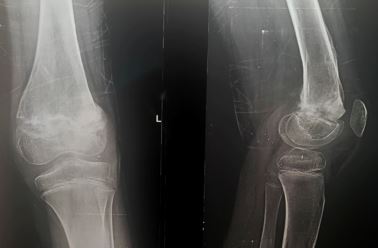Salter-Harris type II fracture of the femoral bone in an 8-year old boy- A Case Report
Abstract
Introduction: Distal femur epiphyseolysis, i.e. separation of physis at the distal femur in the immature skeleton of children consists of physis displacement or fracture or both is rarely seen and is often associated with complications. Physeal fractures or dislocation (also known as knee dislocation) should be treated as a medical emergency usually within 6 hours of trauma by adequate reduction, stabilization and vascular injury repair in order to prevent pre-mature physeal closure, deformity and growth arrest thereby leading to limb length discrepancy.
Case Report: Reported here is a rare case of Salter Harris type II fracture dislocation of the distal femur in an 8-year-old boy who presented to our hospital with swelling and flexion deformity of the left knee 15 days after trauma and was previously treated with slab application and immobilization at a rural health centre. Open reduction and internal fixation was performed with Kirschner wires. These were removed after 6 weeks. Post-operative evaluation after 4 months showed no deformity or limb length discrepancy. Radiograph was suggestive of adequate alignment and no bony abnormality.
Conclusion: Although rare, distal femur epiphyseal injuries of the childhood are of a great concern because of the degree of bone deformities, growth disturbances and significant disabilities caused by them. A detailed study of the these type of injuries helps in deciding the treatment methods and procedures to be opted, which eventually affects the prognosis and outcome in such cases.
Downloads
References
2. Pritchett JW. Longitudinal growth and growth-plate activity in the lower extremity. J Pediatr Orthop. 1992;2(4):557.
3. Zionts LE. Fractures around the knee in children. J Am Acad Orthop Surg. 2002;10:345-355.
4. Brown JH, DeLuca SA: Growth plate injuries: Salter-Harris classification. Am Fam Physician, 1992; 46: 1180–84
5. Ilharreborde B, Raquillet C, Morel E et al: Long-term prognosis of Salter-Harris type 2 injuries of the distal femoral physis. J Pediatr Orthop B, 2006; 15: 433–38
6. Chadwick CJ, Bentley G: The classification and prognosis of epiphyseal injuries. Injury, 1987; 18: 157–68
7. Ogden JA. Skeletal injury in the child. 3rd ed. New York: Springer, 2000: 1198 pp.
8. Neer CS. Separation of the lower femoral epiphysis. Am J Surg 1960; 99: 756–761.
9. Cassebaum WH, Patterson AH. Fractures of distal femoral epiphysis. Clin Orthop 1965; 41: 79–91.
10. Plánka L, Nečas A, Gál P, et al. Prevention of bone bridge formation using transplantation of the autogenous mesenchymal stem cells to physeal defects: an experimental study in rabbits. Acta Vet Brno 2007; 76: 257–266.
11. Gál P, Nečas A, Adler J, Teyschl O, Fabián P, Bibrová Š. Transplantation of the autologous chondrocyte graft to physeal defects: an experimental study in pigs. Acta Vet Brno 2002; 71: 327–332.

The entire contents of the Orthopaedic Journal of Madhya Pradesh Chapter are protected under Indian and International copyrights. Orthopaedic Journal of Madhya Pradesh Chapter allow authors to retain the copyrights of their papers without restrictions, Authors grant the publisher the right of exclusive publication. The Journal then grants to all users a free, irrevocable, worldwide, perpetual right of access to, and a license to copy, use, distribute, perform and display the work publicly and to make and distribute derivative works in any digital medium for any reasonable non-commercial purpose, subject to proper attribution of authorship. The journal also grants the right to make numbers of printed copies for their personal non-commercial use under Creative Commons Attribution-Non-commercial share alike 4.0 International Public License.

 OAI - Open Archives Initiative
OAI - Open Archives Initiative












